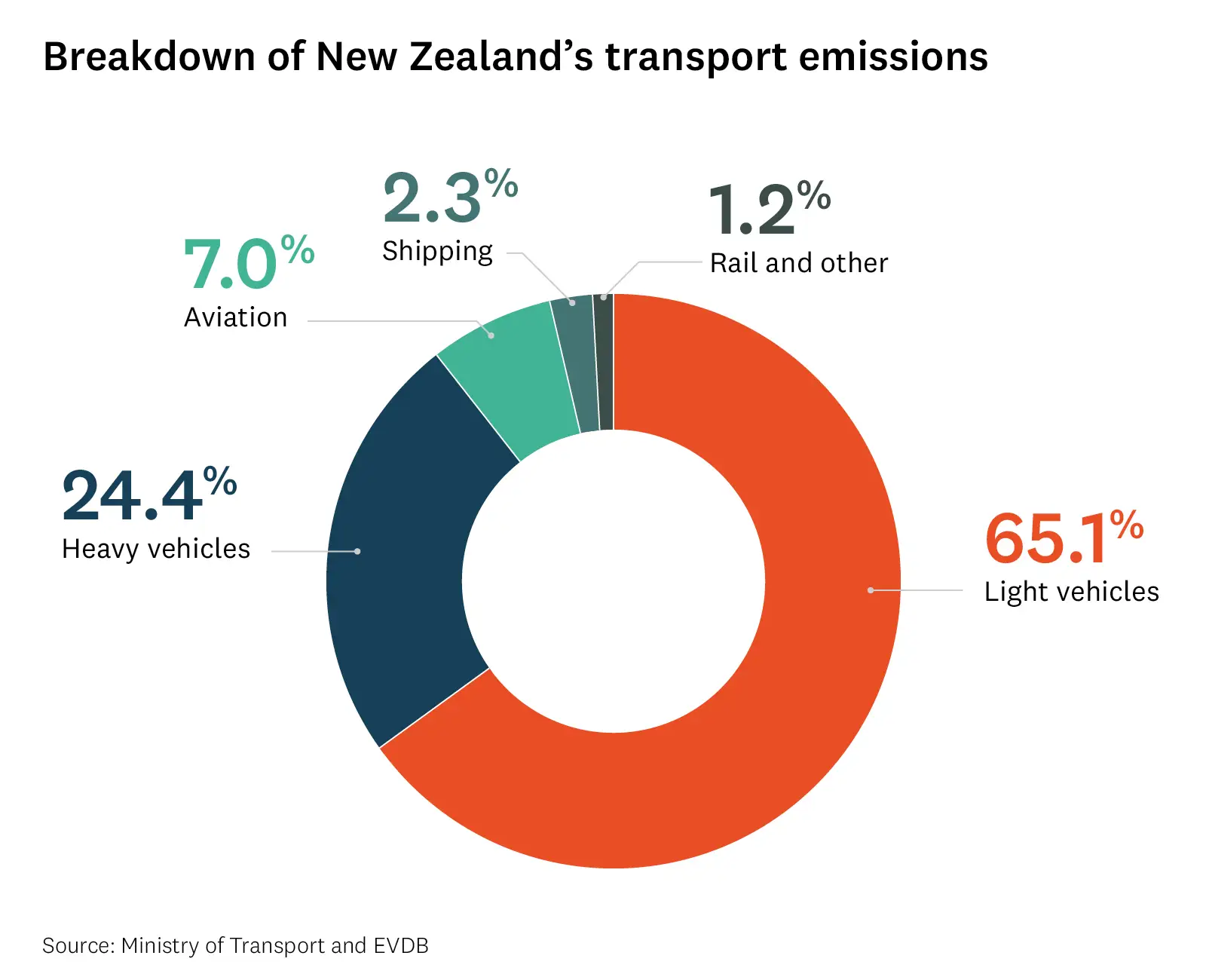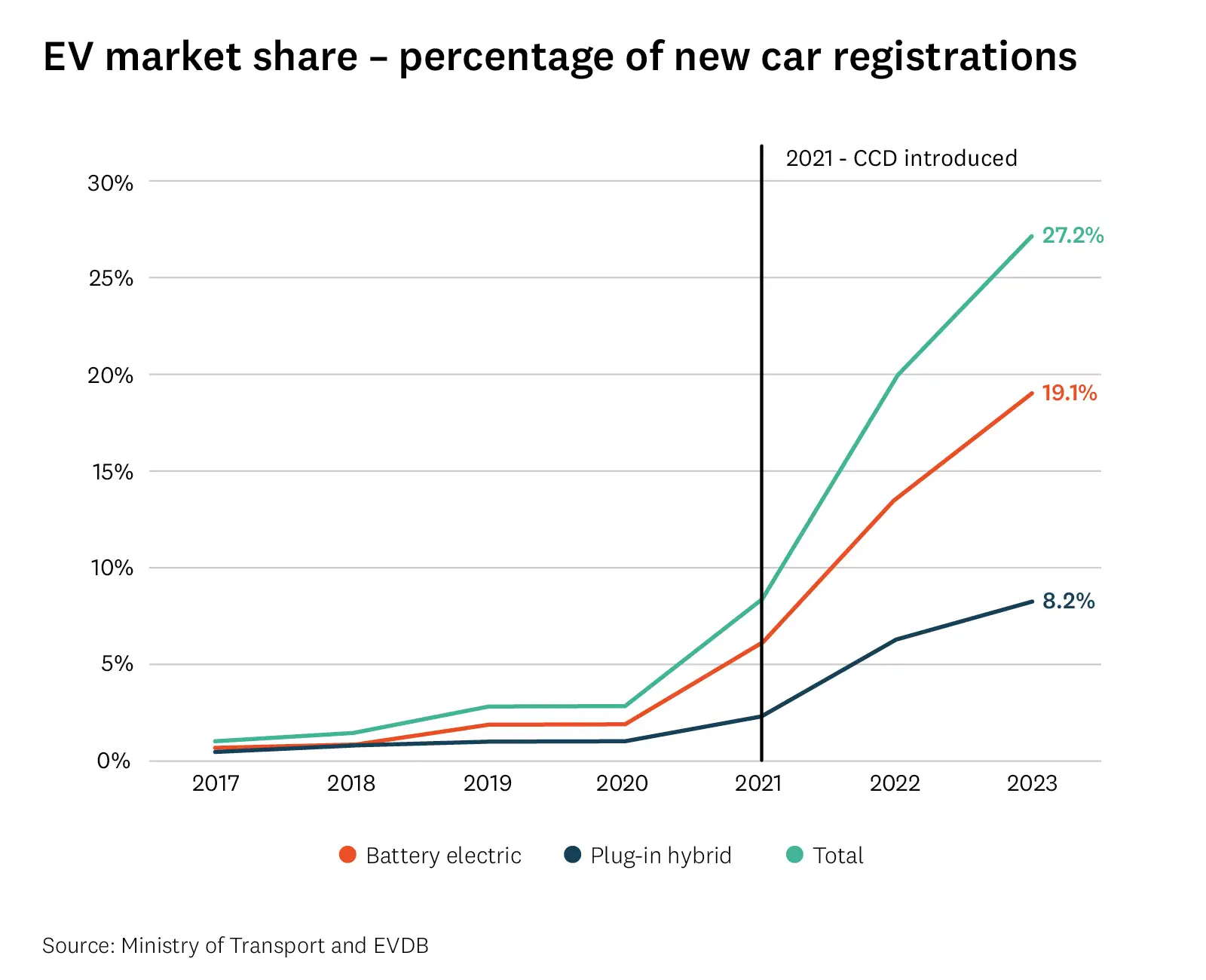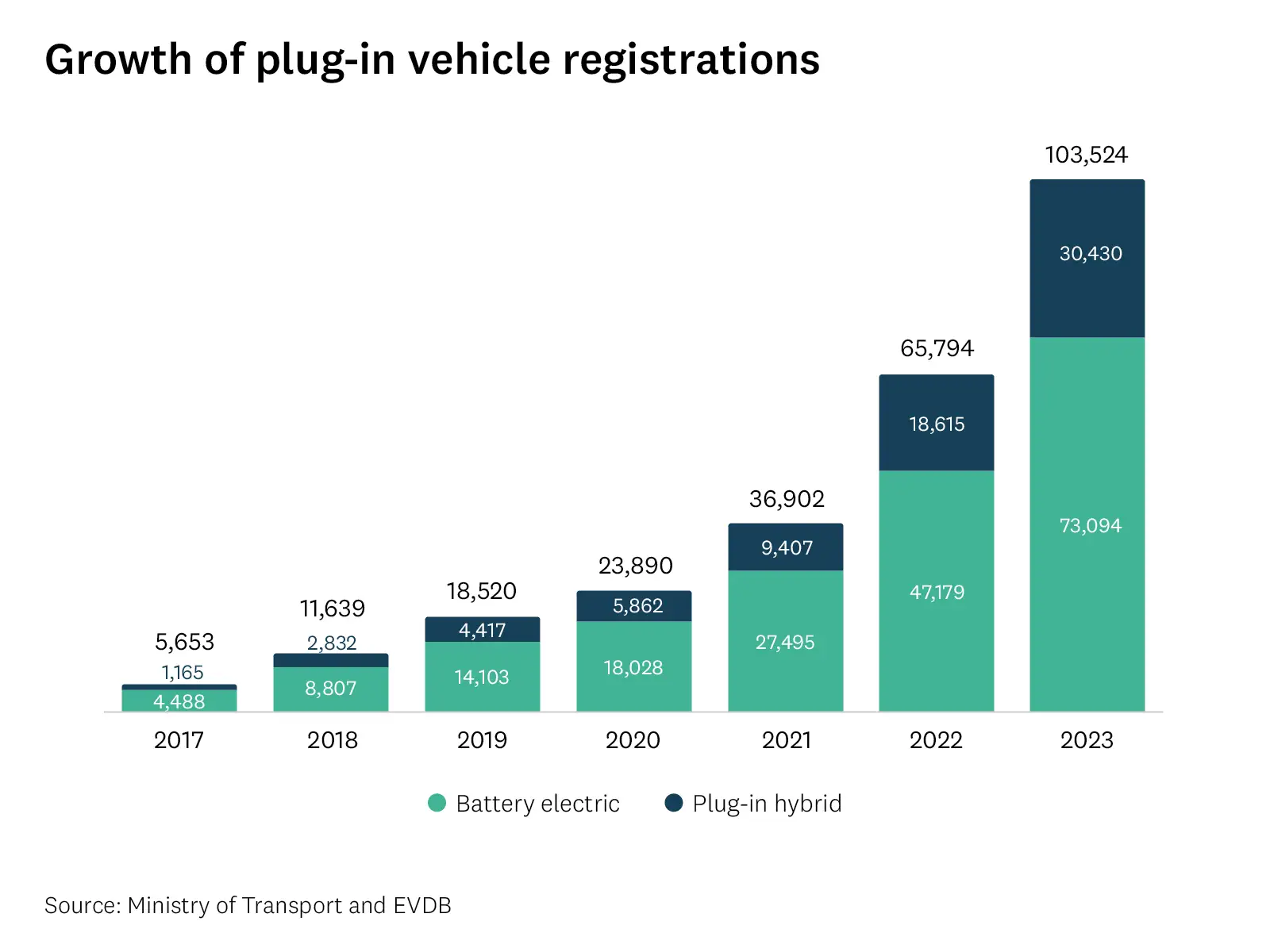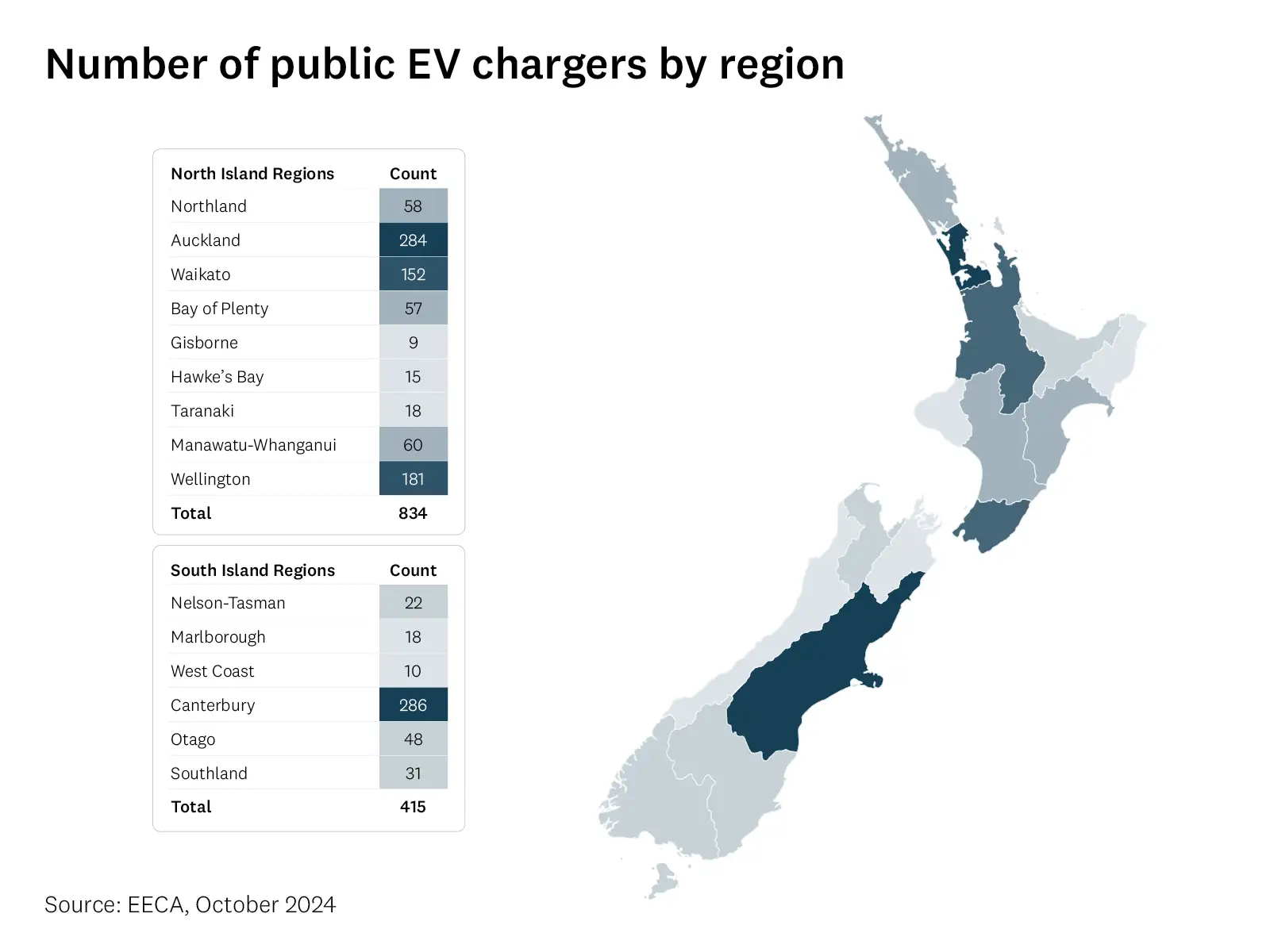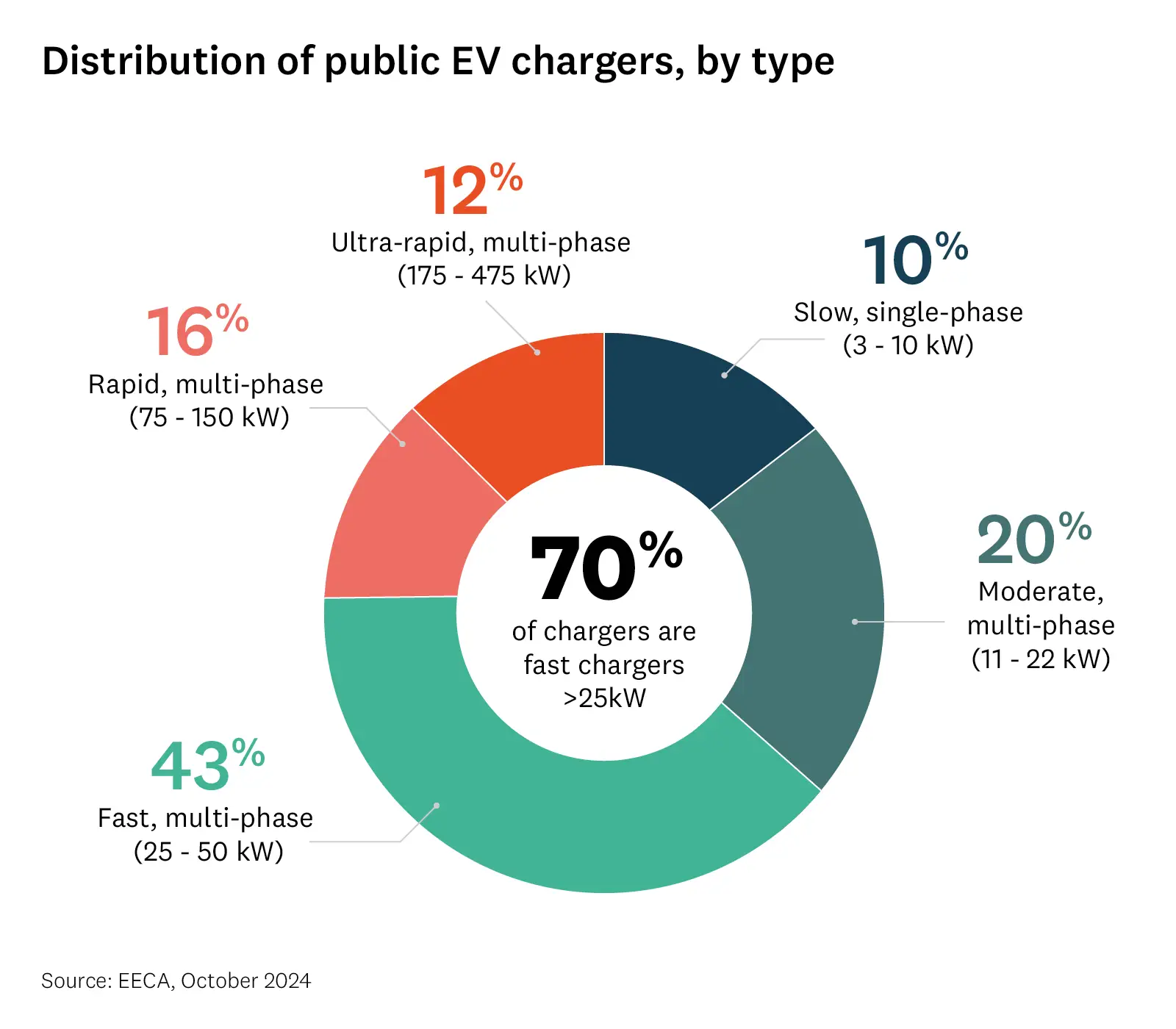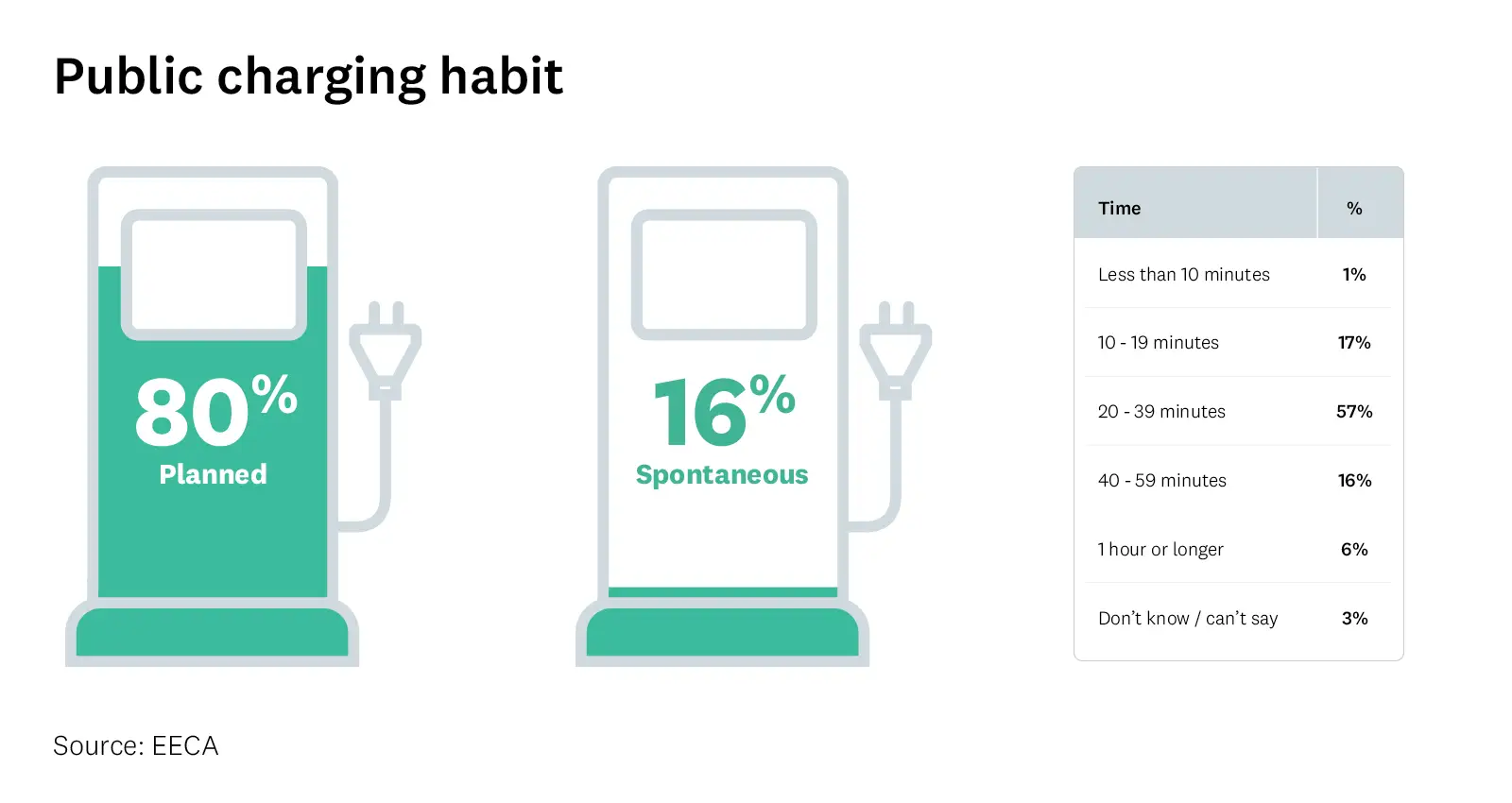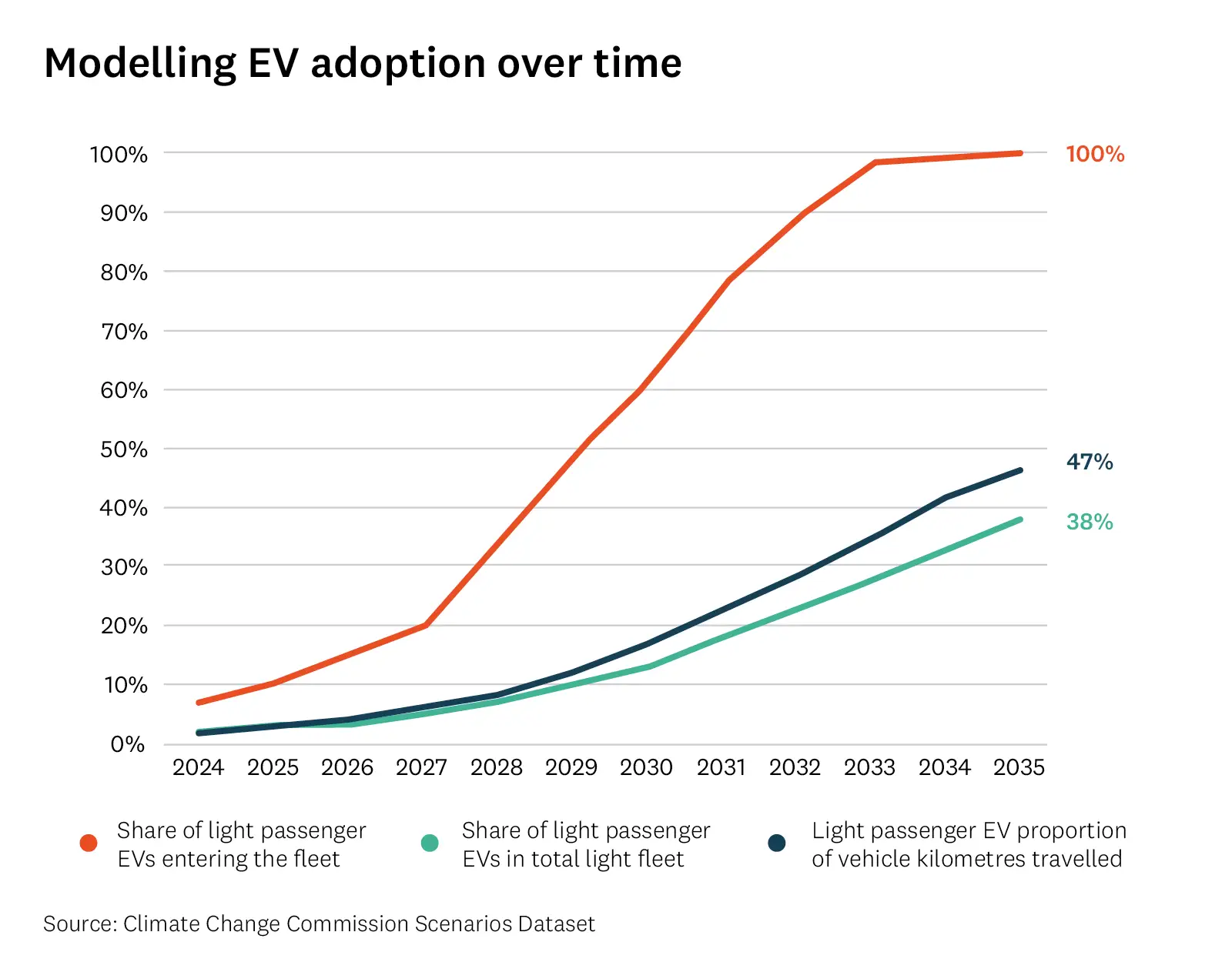Transitioning to electric vehicles is a vital element of New Zealand’s shift toward clean energy and our target to be net carbon zero by 2050.
Good public charging is crucial to EV ownership
4:40 minutes
The number of EVs on New Zealand roads has increased significantly in recent years and will continue to grow.
While EV owners generally do the majority of their charging at home, the public charging network is expanding to meet growing demand and will play a crucial role in the expansion of EV uptake.
Learn about the public charging network in New Zealand, and how we're preparing for the future.
On this page
- The journey to electrifying our roads
- The rapid growth of EV ownership in New Zealand
- How many public chargers are there in New Zealand?
- Investment in public charging facilities
- Public charging behaviour
- Expanding our charging network
- EV charging infrastructure challenges
- The future of EVs and charging
- Managing the growth in electricity demand
- How EV technology is evolving
- Specifications for EV chargers
The journey to electrifying our roads
Transport emissions account for around 17% of New Zealand’s total emissions, with 99% of our transport energy coming from fossil fuels.
New Zealand has one of the highest rates of car ownership in the world with 0.89 vehicles per capita and this number is increasing. This high level of private car ownership means that these vehicles account for nearly two thirds of New Zealand’s transport emissions. Every year, we drive a collective 49 billion kilometres, the equivalent of going round the planet 1.2 million times, or halfway to the sun.
Because of this scale, transitioning to an electric light vehicle fleet and initiatives to reduce the amount we travel by car will make a significant impact in our journey to reduce our carbon emissions. There are also substantial additional benefits including cleaner air, quieter roads and cheaper running costs for drivers.
The rapid growth of EV ownership in New Zealand
The rate of EV ownership has been increasing exponentially over recent years, and in 2023 more than one in four (27.2%) cars purchased were either battery electric or plug in hybrid. This represents a ten-fold increase in just four years. This early adoption and growth is crucial, as any new internal combustion engine (ICE) vehicle purchased today, will likely still be on our roads for years or even decades to come whilst continuing to emit CO2 throughout this duration.
The surge in EV adoption can be attributed to several factors, including the introduction government policy such as the Clean Car Standard, the improved affordability and range of EVs, and the expansion of EV makes and models.
By the end of 2023, there were over 100,000 battery electric and plug-in hybrid cars registered on New Zealand roads, a 57% increase on 2022. Looking back five years, this represents a 790% increase since 2018.
EV ownership is growing fastest in urban areas
The increase in EV ownership in New Zealand tends to be centred in urban areas and major cities. Wellington currently leads the way in EV adoption with more than two times the national average of EV ownership at (3.38%). Auckland is in second with around 2% of its light passenger vehicle fleet being comprised of EV.
It is important to note that these numbers are influenced by government and corporate ownership of EVs, which may not accurately reflect the location where these vehicles are used.
This map shows the percentage of EVs in the light vehicle fleet across New Zealand districts. (Data source: EECA, Ministry of Transport).
EV owners want more public charging facilities
A 2023 EECA survey of New Zealand EV owners found a strong desire for more public charging facilities.
- 2 in 5 think there aren’t enough public chargers on routes they travel.
- 1 in 5 have range anxiety – concerns about running out of charge before they reach their destination.
How many public EV chargers are there in New Zealand?
The number of public charging units or ‘chargers’ in New Zealand is growing. These public chargers tend to have multiple connectors or ‘charging points’, that means that charging units can usually charge more than one EV simultaneously. According to EECA data, as of October 2024, there are over 1,200 public charging points in the country, or around one charging point for every 60 EVs.
Find the latest data on our Public EV Charger Dashboard
Over two in three public chargers are fast chargers with capacities of greater than 25kW. At the fastest end of the spectrum, more than one in four chargers are either rapid (75-150kW) or ultra-rapid (175-475kW), which are predominantly used for journey charging.
Public EV chargers have predominantly been installed in regions of higher population and EV ownership, such as New Zealand’s major cities of Auckland, Wellington and Christchurch.
Public charging categories
-
Journey charging
For recharging during long journeys.
Chargers are usually located in places which are convenient for long-distance travel, such as state highways. Typical locations include at service stations or public rest areas. Charging ‘hubs’ have the capacity to charge multiple vehicles at once.
These chargers range from rapid to ultra-rapid (50kW–475kW). Charging normally takes 15–45 minutes. -
Destination charging
For charging where the user may park for a number of hours.
Chargers are located at destinations such as tourist attractions, shopping centres, gyms, cinemas.
These chargers are useful for EV owners who do not have home charging (e.g. no off-street parking) and may need to complete most of their EV charging with these chargers.
These chargers tend to be fast chargers and can recharge an EV in 1–2 hours. -
Residential on-street charging
Close-to-home charging for EV owners without off-street parking or the ability to charge at home.
Charging stations are installed to serve vehicles parked on-street in residential areas.
These chargers tend to be lower capacity, and can be used for charging over long periods, or overnight.
Investment in public charging facilities
Businesses in New Zealand are increasingly investing in chargers with companies such as Meridian, BP, Z Energy, ChargeNet, WEL Networks, Jolt, Tesla and several electricity distribution businesses (EDBs) including Network Waitaki, Alpine Energy, Orion, and Marlborough Lines now operating charge points across the country. New Zealand is now starting to gain critical mass as more operators enter the market and this market continues to mature.
Since 2016, EECA has supported the installation of the majority of public EV charging stations across the country with co-investment through the Low Emission Transport Fund (LETF). Over 1,200 private and public EV chargers have been co-funded with the aim to accelerate and expand the charging infrastructure to enable EV uptake and overcome perceived barriers like range and charging anxiety.
The Government has committed to accelerate electric vehicle charging infrastructure with a comprehensive, nationwide network of 10,000 public EV chargers by 2030, taking into account the need to ensure maximum benefit for government investment. The best means to do so is currently being explored.
EECA's 2023 EV driver survey found that
- 76% of EV drivers use public chargers.
- 97% of EV drivers charge at home.
Public charging behaviour
Public charging is widely used by New Zealand’s EV drivers with around three in four using public charging to help recharge their cars – usually for top ups whilst undertaking longer trips around the country.
A 2023 EECA survey of EV owners found that the number of drivers who use public chargers has increased significantly over the past couple of years from 49% in 2021 to 76% in 2023. These numbers reflect that public chargers are becoming more widely available and are increasingly becoming a part of an EV owner’s charging regime.
The most common type of trips among EV owners who use public charging are long weekends or holiday trips, whilst travelling longer distances, with three in four (75%) topping up on the road. Not surprisingly, very few drivers publicly charge whilst doing their daily commute (15%), or whilst making short trips around town (14%), instead opting to charge at home.
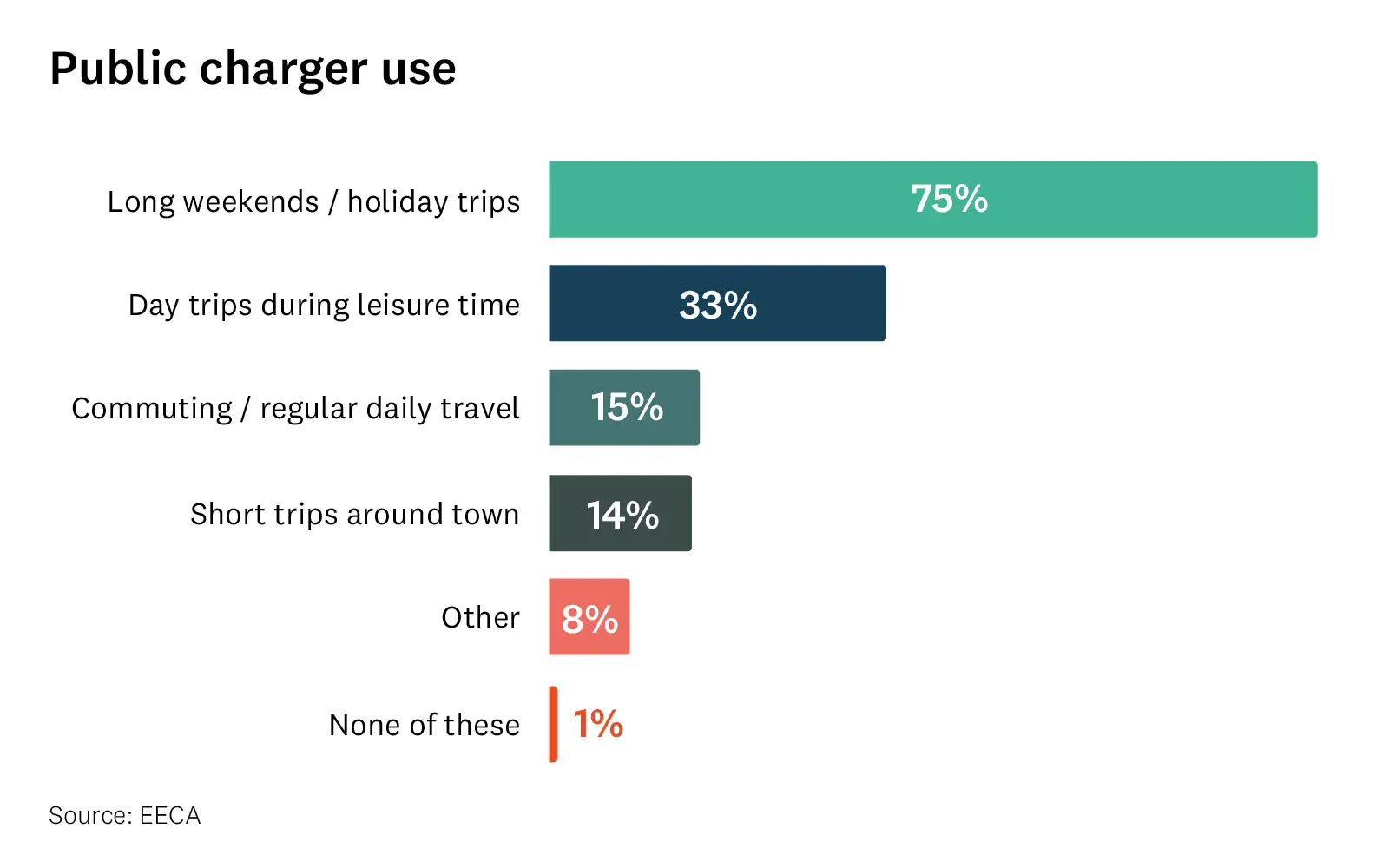
80% of EV drivers plan ahead when it comes to using public chargers
For four in five EV owners who use public charging, the use of public chargers is planned, that is, they predetermine their route and charging options ahead of time to ensure they have sufficient battery charge to complete their journey. In contrast, spontaneous charging is undertaken by fewer than one in five EV owners. When charging, most EV owners (79%) tend to charge for 20 minutes or longer, with the most common time of charging being between 20–39 minutes (57%) indicating that they are having substantial charging sessions.
Expanding our charging network
Currently, there are public chargers at least every 75 kilometres on most of the state highway network. This means that drivers are almost never too far from their next charge when they are taking longer journeys. The public charging network is growing all the time, with a focus on strengthening major routes and plugging gaps in areas with limited EV charger coverage.
When planning the location of public chargers, a number of key aspects are usually considered such as:
- Major traffic routes and traffic volume
- Distance between existing public hubs and chargers
- Capacity and location of existing chargers on the routes
- Nearby amenities
- Future roading upgrades
Most EV charging happens at home
Public charging is just part of the EV charging equation. Private home charging is a critical component of New Zealand’s EV charging outlook and is where a vast majority of EV charging takes place with 97% of EV owners charging at home at least some of the time.
Unlike internal combustion engine (ICE) vehicles, EVs have the advantage of being able to be refuelled at home via home charging. This means that network strain is not centralised at public charging stations, rather it is distributed across homes helping to lessen the burden on the network.
The National EV Charging Strategy aims to improve equity of and access to home charging infrastructure and will investigate options such as charging for renters, homes with limited or no off-street parking, and multi-unit dwellings and social housing.
EV charging infrastructure challenges
Building out our country’s EV charging infrastructure is a large undertaking. To do so, Government and the private sector need to overcome several key challenges.
- Commercial ROI – New Zealand’s EV fleet is not yet large enough to be commercially viable for private companies to invest in EV charging infrastructure across the whole country, rather it tends to be in locations of high demand. Faster rapid and ultra-rapid chargers have higher costs such as the upfront cost for the charger and electricity network upgrades, and ongoing electricity lines charges. Given the convenience of home charging, public charging will only provide a small percentage of energy for EVs, with higher usage likely only being seasonal, for example during summer holiday season. As a result of these factors, some locations may never be commercially viable.
- Low density usage – There are specific challenges around EV charging provision in low population density areas. Rural areas tend to have less robust electrical infrastructure, which can affect the speed and volume of chargers available. Electricity supply upgrades in ‘grid edge’ locations are expensive, and there is often not enough new electricity demand from businesses or industry to support the investment or upgrades in rural areas. The commercial viability of rural chargers is also lower than in cities, due to a lower utilisation rate which can make attracting investment more difficult.
- Site securing and resource – Finding the right locations to ensure that the chargers are in the optimal place to EV owners to fuel up is crucial. Navigating the resource consents and standards for some types of charging stations can be a complex and lengthy process. Some councils are helping to speed up this process by making public EV charger installation a permitted activity removing the need for resource consent.
- Standardisation and interoperability – New Zealand’s public EV charging infrastructure is dominated by a few charging suppliers, meaning EV drivers can use the current charging system relatively easily. As the market expands, we expect new entrants and greater competition in charging infrastructure, which, if not properly managed could mean a number of different and competing payment systems which could add complexity to charging for EV drivers.
- Electrical network upgrades – Some larger charging stations will require the same amount of power as a medium-sized town. This necessitates significant investment in network upgrades from electricity distribution businesses (EDBs). The capital contribution policies of EDBs differ, but some EDBs would require the business investing in EV charging infrastructure to pay for these upgrades regardless of whether they need all of the additional capacity.
- Energy supply – EVs require electricity at a time when other New Zealand sectors are electrifying to support their decarbonisation objectives. This increases pressure on electricity demand and infrastructure, which could require significant investment in renewable generation and upgrades to transmission and distribution networks. Unmanaged, EV charging could exacerbate electricity congestion at peak times when the grid is under the most pressure. Fortunately, New Zealand has enough current and consented electricity generation to meet this increasing demand. Home charging during off-peak times, will also help manage demand.
Battery storage and on-site solar generation could help address occurrences where localised electricity supply is constrained. For example, EECA has co-funded a public charging site located in Springs Junction on the Lewis Pass, where three battery units are charged overnight when more electricity supply is available, and then use the stored energy to power the EV chargers during the day.
The future of EVs and charging
The Climate Change Commission’s (the Commission) modelling suggests that by 2030 up to 550,000 light passenger and light commercial EVs will be operation on New Zealand roads.
By then, annual light EV registrations are expected to reach 62% of the market, and by 2035, 100% of cars entering the New Zealand fleet, both new and new second-hand imports, will be electric. This would mean that, by 2035, 38% of our total light vehicle fleet will be EVs.
With this, the proportion of kilometres travelled by light passenger EVs in New Zealand will also dramatically increase from just over 2% in 2024, to nearly half (47%) in 2035, transforming our energy demand nationally.
We can expect larger charging hubs
On the roads, large charging hubs will continue to be rolled out as a main means of journey charging. It is likely that the size of the hubs themselves will also grow and these larger hubs will become more common. This will see increases from the current charging hubs of 6–10 chargers, to hubs of up to 20 chargers.
These will continue to be located along our state highways and will look similar to large petrol stations. These charging hubs will predominantly be used for recharging whilst on longer journeys and will be designed to accommodate light trucks and light vehicles with trailers. They will largely be comprised of rapid and ultra-rapid chargers.
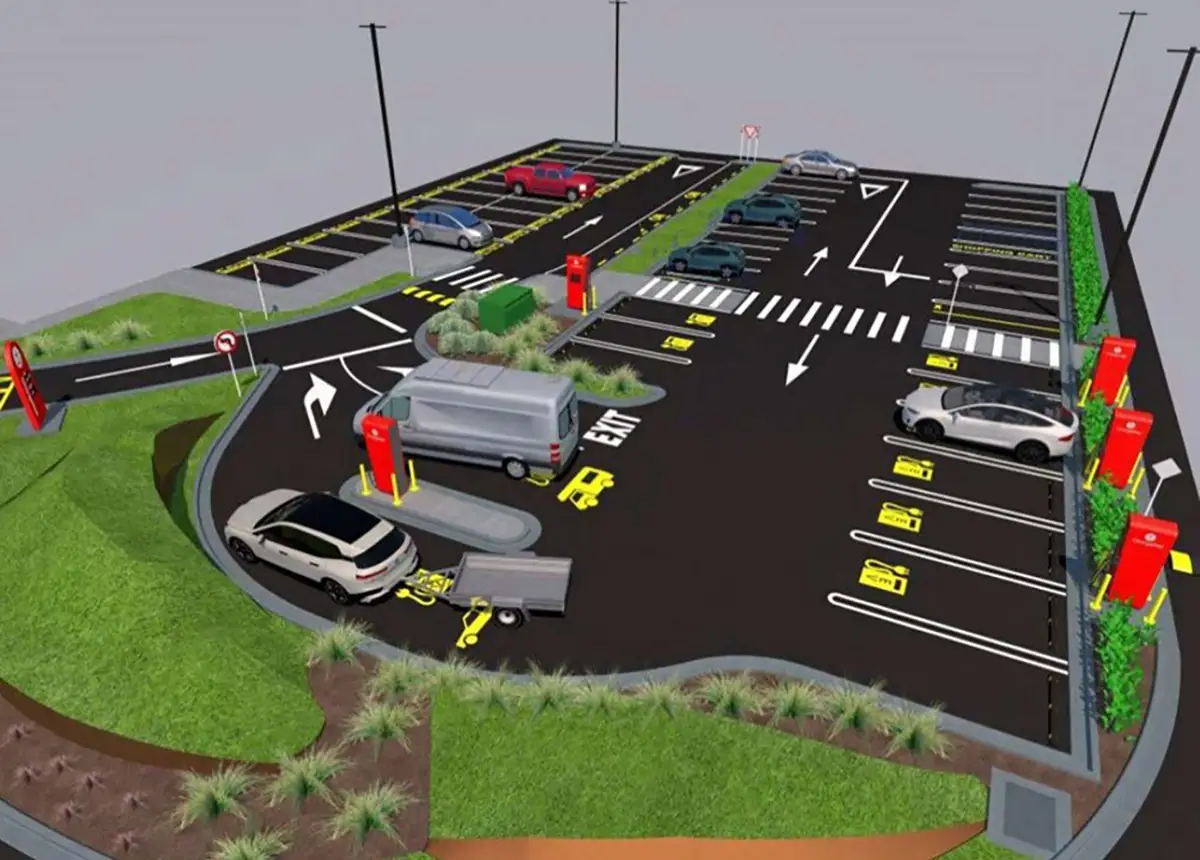
These charging hubs could also increasingly look to on-site solar electricity generation and battery storage technologies to help supplement electricity supply to the chargers and lessen the burden on the grid. Indeed, many charging hubs overseas are installing solar panels as part of EV hub roofing to give shelter to the driver and EV whilst charging and help generate electricity.
This network will increasingly be supplemented by chargers located at petrol stations as they continue to transition their network of stations to support EV charging. Other greenfield sites around the country will also be developed to meet local demand. Businesses will also increasingly provide charging at their car parks for their customers and employees, and public parking will continue to see further roll out of chargers.
Managing the growth in electricity demand
Currently, if properly managed through demand flexibility, we have plenty of energy supply to power a growing EV fleet. EECA modelling suggests that if all light vehicles in New Zealand were electric, our current total electricity demand would increase by around 20%.
This could be accommodated within New Zealand's current electricity grid infrastructure system, provided that the charging demand is managed. For example, that the majority of EVs are charged via smart chargers during off-peak times at home, when there is greater excess supply of electricity in the grid. Given the convenience and lower cost, home charging will likely remain the main source of charging for EVs in New Zealand.
Demand will also be managed by the public chargers as well. Many chargers being installed today have connectivity which enables remote communication, monitoring, and control between the charging stations and the central management system.
These chargers can dynamically manage the electric load based on real-time conditions, such as how many EVs are charging and at what capacities, and they can adjust the charging power based on grid capacity and charging demand to help distribute the electricity demand evenly.
This smart interoperability will enable the chargers to participate in demand response, whereby the charging rates and sessions can be adjusted and scheduled based on signals from the grid. During periods of peak demand, the chargers can reduce charging rates or delay charging to reduce demand.
It is likely that time-of-use pricing models will also be used in the near-future which will work on a similar principle to off-peak charging times in the home, adjusting the charging rates based on electricity demand and pricing during different times of the day. This will help incentivise EV owners to charge up during off-peak hours when electricity is less expensive and will help to balance electricity demand.
Meeting the increased demand for public chargers will take both public and private funding and extensive and careful planning to ensure that the electrification of our roads is managed in a manner that encourages the uptake of EVs in New Zealand and enables our transport to transition away from fossil fuels sustainably, equitably and securely.
How EV technology is evolving
EVs
By 2030, the number of brands, types and models of EVs will have expanded greatly to respond to market demand with a variety of models ranging from affordable compact cars to high-performance luxury vehicles and electric SUVs. Manufacturing costs will continue to decrease, which will make EVs more accessible and affordable to a broader range of consumers.
Accessibility will also be increased as the second-hand market matures, and a greater number of pre-owned EVs enter the market giving consumers a cheaper entry point. Beyond serving as a means of transportation, electric vehicles will increasingly become essential components of the larger energy ecosystem.
The implementation of vehicle-to-home (V2H) and vehicle-to-grid (V2G) technology has the potential to allow EVs to contribute surplus power to the home or even back to the grid during peak demand periods, helping to manage home and grid demand and offer EV owners the ability to save on their energy bills.
Batteries
There is a strong desire from consumers to have EVs with longer ranges and to minimise the number of times they have to charge their vehicle and reduce range anxiety. This will first be addressed with continued advancements in current lithium-ion battery technology which are expected to lead to EVs with longer ranges of over 800km and improved performance through reductions in battery weight and increases in capacity.
New battery technologies such as solid-state lithium-ion batteries are also predicted to enter the EV market as early as 2027 – 2028. Solid-state batteries have a higher energy density to standard lithium-ion batteries, which means they can store more energy in the same volume. They can also be charged faster. This means that we could see EVs on New Zealand roads with ranges of over 1,000km, that can be recharged with a fast charger in around 10 minutes (SoC = 10 – 80%).
Many EV batteries will also shift from the currently common 400-volt architecture to 800-volt architecture which will allow for higher, more sustained charging power and faster charging speed, plus increased efficiency and better performance.
Chargers
Our public journey chargers will also have to evolve to meet the increased energy demand of larger batteries. This will mean an even greater number of our public journey charging will need to be ultra-rapid (>100kW) to ensure EVs can recharge quickly whilst on the road.
Increased EV range will mean that the need for public destination chargers will not change dramatically, as most charging will still be done in the home. However, when needed and to account for larger batteries, destination charging will also need to increase in capacity to recharge them at appropriate rates. This will likely see destination charger capacities increase from predominantly 25kW to 50kW or higher chargers.
There will also need to be an expansion of residential public charging into the suburbs to the point that a low-capacity kerbside charger in a suburban street becomes much more common, and will also help address the need of EV owners who live in dwellings without home or off-street charging.
Specifications for EV chargers for commercial and residential use
Commissioned by EECA, Standards New Zealand has published Publicly Available Specifications (PAS) for electric vehicle chargers for residential and commercial use.
This guidance has been developed to respond to increasing uptake of EVs in New Zealand and a need to provide retailers and consumers with quality guidance.

